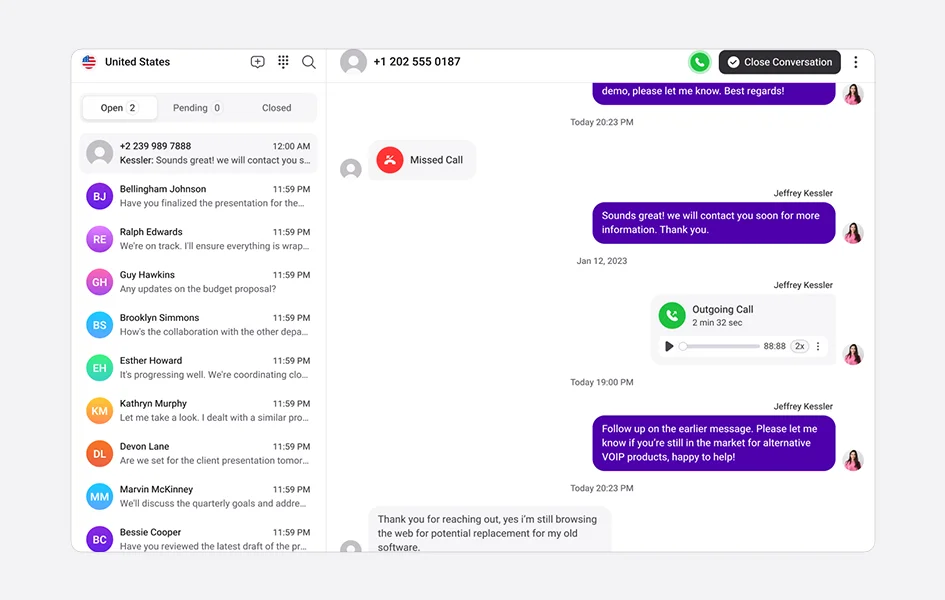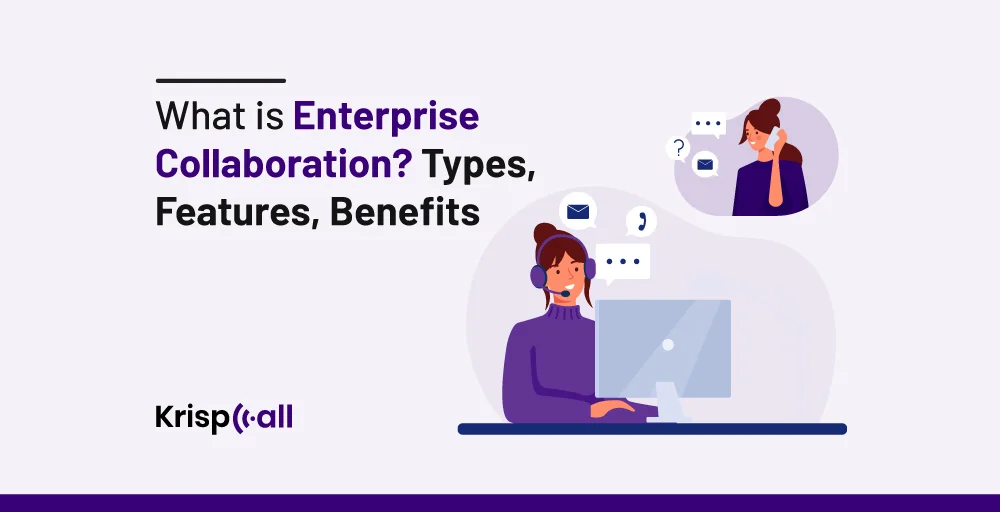While technology continues to advance and prove more helpful to organizations, companies are progressively embracing varied software programs to increase efficiency, output, and the future of work. 💪
The enterprise collaboration system 🤝 is a crucial component among these tools, facilitating close interaction among team members and even those working remotely daily.
This guide will explore enterprise collaboration in more detail with its types, features, and benefits.
🔑 KEY HIGHLIGHTS
- Enterprise collaboration is an assertive communication and collaboration system within an organization. It empowers people to work together efficiently and productively to complete a project or achieve a shared goal regardless of location.
- Two types of enterprise collaboration exist: Internal Enterprise Collaboration and External Enterprise collaboration.
- The key features of an Enterprise Collaboration System are cloud-based file storage and improved transparency.
- Using KrispCall Unified Communication Solution, you can view calls, SMS, voice mails, and other intriguing functions simultaneously.
What is Enterprise Collaboration?
Enterprise collaboration is a system where individuals work productively across locations to complete projects or achieve mutual goals through efficient communication and cooperation.
Enterprise collaboration is when people connect with the right enterprise or information at the right time to drive the right businesses. Enterprise collaboration and communication is a critical success factor in today’s knowledge-based economies.
The main goal of enterprise collaboration is to promote unity, facilitate employee sharing of ideas and teamwork, and ultimately increase the company’s overall growth.
Types of Enterprise Collaboration
Enterprise collaboration can be categorized into two types: Internal enterprise collaboration and External enterprise collaboration.
Internal Enterprise Collaboration
Internal enterprise collaboration refers to the cooperation of an organization’s team members, employees, and departments. When the members of an organization need to collaborate to discuss team goals or solve a common problem, it is called Internal enterprise collaboration.
External Enterprise Collaboration
External enterprise collaboration is cooperation that mostly happens on social media platforms. It can also occur between companies that must collaborate on products or services. This type of collaboration allows you to learn about your clients and partners and provides feedback that initially helps improve your product.
Why developing an enterprise collaboration is essential?
Collaboration plays a vital role in a business’s success. Internal collaboration increases productivity, while external collaboration with clients and partners provides critical feedback that gives motivation and builds trust in the company.
Collaboration can significantly impact the company’s profitability for evaluation and guidance. When communication channels are open, finding the necessary information makes it easier to turn to a colleague and customer for evaluation and proper guidance.
The most compelling factors in developing an enterprise collaboration are:
- To improve physical barriers: Many enterprise collaboration tools are cloud-based, so they can be used from anywhere (the users only need an Internet connection), thus allowing team members to interact regularly despite geographical distance.
- To keep everyone in the know: Effective collaboration can guarantee that more people are aware of current happenings, keep everyone updated, and keep the team’s progress.
- Enhanced decision-making prowess: All the files are saved in a centralized location, making it comparatively more accessible than physical ones to make decisions and inform themselves. Collaboration tools simplify updating documents and have a notification feature in their software. So everyone in the organization can have the latest updates about enterprise activities.
What are the key features of an Enterprise Collaboration System?
Let’s discuss some of the critical features of an enterprise Collaboration System.
1. Cloud-based file storage
An organization’s members must access files from one location. Cloud-based storage allows remote workers to quickly access the data to complete the project or publish the content.
This feature of effective collaboration software increases the whole team’s productivity, more precisely when team members share the files.
2. Improved transparency
Enterprise collaboration solutions enable employees to track and manage projects quickly, create personal accountability, and establish higher levels of trust, resulting in more openness inside the organization.
3. Improved teamwork
Real-time team communication leads to more productive and efficient collaboration. Furthermore, centralized file storage minimizes errors and confusion among team members. Cross-team communication is promoted and enhanced when all employees cooperate on the same platform.
4. Less use of apps, higher efficiency
An enterprise collaboration platform provides a unified platform for the organization’s communication and collaboration needs. It allows employees to manage and handle all tasks effectively, eliminating the need to switch to different apps, which can be time-consuming. This streamlined approach increases productivity by eliminating redundant programs with overlapping functionalities, inspiring the team to work more efficiently.
Creating a Unified Enterprise Collaboration System
Enterprise collaboration systems are a significant investment, as they help boost your team members’ understanding and capabilities with functions designed to make communication, cooperation, and information management more effortless.
Most of the software has the ability for integrations that allow them to integrate with other apps, extend their functions, and create a more streamlined digital workplace.
Here are some examples of some effective enterprise collaboration platforms:
Unified Communication Software
Unified communications software allows team members to interact with each other regardless of their location. In other words, members can use all the communication channels needed in an enterprise, such as voice calls, SMS text messages, and MMS.

For example, a collaboration platform like KrispCall allows you to simultaneously view calls, SMS, voice mails, and other intriguing functions. You also don’t need to take notes during a meeting, as KrispCall has a call recording feature and can transcript voice recordings.
Project management apps
Enterprises use many apps to improve teamwork, track employee performance, and manage schedules and task lists. They offer instant messaging and notification features that assist in consolidating all project-related interactions. Still, they lack UCaaS capabilities such as phone and video—you’ll need to use communication tools like KrispCall.
Document management system
While working in an organization, you must share the documents with other team members while working on the project, instead of sharing the physical form of paper with others that make piles of paper all around. You can use digital methods to share these files.
Many document-sharing software programs, like Google Docs or Microsoft SharePoint, help businesses share files with different departments and locations.
What Challenges does an Enterprise Collaboration organization face?
Enterprise solutions are not straightforward, and they have some complications. Let’s discuss all the challenges enterprise collaboration organizations face.
- Lack of Standardization: Employees can use different or even the same software from other versions. This can lead to various complications, making sharing files and information difficult and making it difficult to work on the same project.
- Lack of Visibility: Ineffective cooperation and a lack of standards lead to improper execution of plans to complete the project. In bigger organizations, employees must understand the company’s vision to submit better-aligned goals.
- Lack of Alignment: It is another problem that most organizations face today. When teams in a company work towards different goals, it causes uncertainty among the team. Without adequately optimized goals and effective communication, projects can stay uncompleted; resources can be used inefficiently, which might cause conflicts. Due to this lack of alignment, teams may find it challenging to collaborate effectively, slowing development and making it more difficult to provide the best results for clients.
- Lack of Communication: Enterprise organizations have organized processes in which team members must connect with other departments. This makes it difficult for employees to communicate with each other, which results in better decision-making, clarity, and productivity. Lack of communication can also waste time and effort as team members try to figure out who to contact for the needed information or help. They’ll have to look up contact information if they need simple access to a company directory or organizational chart.
What are the Enterprise Collaboration Solutions?
The critical enterprise collaboration solutions are:
1. Make a central repository for the project
A centralized repository for all project-related information can significantly improve team collaboration. This can be a shared drive, an intranet website, or online project management applications.
A central repository ensures that everyone can access the most recent version of project papers and that no vital information is lost. Many project management solutions can also notify team members when a delivery is made.
2. Develop clear communication guidelines
Organizations should provide explicit norms for how various teams should communicate with one another. Establishing clear lines of communication, scheduling frequent meetings, and defining roles and duties also helps.
By creating rules, you ensure that everyone is on the same page and that initiatives progress in a coordinated manner. Standards for upward communication should also ensure that senior management is kept up to date on project development and is aware of any possible problems that require their attention.
3. Encourage team communication
Open team communication is essential for many reasons. Team members can share their ideas with their team manager. This can help build trust among the leaders and members.
Connecting and holding meetings with teams and clients, establishing multiple communication channels like email and video conferencing, and building policies around their use.
4. Create a collaborative environment (physical or virtual)
Create a team room where all team members from different departments can meet up and share the progress and complications of a project. Moreover, a conference room should be built where staff members from various departments can collaborate on projects or a virtual meeting space where distant workers can interact.
Conclusion
Enterprise collaboration has become an essential element for businesses of all sizes in today’s fast-paced and interconnected world. It encompasses various types of collaboration tools, platforms, and practices designed to facilitate communication across departments, teams, and locations.
Implementing effective enterprise collaboration not only strengthens internal operations but also enhances adaptability in today’s dynamic business world. These include improved efficiency, increased productivity, enhanced innovation, faster problem-solving, and a more decisive competitive edge.
FAQs
What is an Enterprise Collaboration System?
Enterprise collaboration is a communication and collaboration system in which people work together efficiently and productively to complete a project or achieve a shared goal regardless of location.
What are the different types of enterprise collaboration software?
The different types of enterprise collaboration software are messaging and chat tools, document-sharing tools, workflow automation software, and Unified communication platforms.
What are the different enterprise collaboration tools?
The different enterprise collaboration tools are:
Slack: Slack is a cloud-based team communication platform developed by Slack Technologies that allows your team to send instant messages, create groups, and provide links to files.
Google Drive: Google Drive is backup and cloud storage software that allows your team to easily access files, documents, and photos.
Zoom: Zoom is a widely-used video conferencing tool that provides valuable features such as screen sharing, virtual backgrounds, and breakout rooms, enabling teams to easily connect and work remotely.
Why does a business require an enterprise collaboration system?
Businesses require enterprise collaboration to increase their overall productivity. Different ECS tools help solve the problems many organizations face today.
Any organization members may need to retrieve the data from the company server to publish the content or complete the project.





